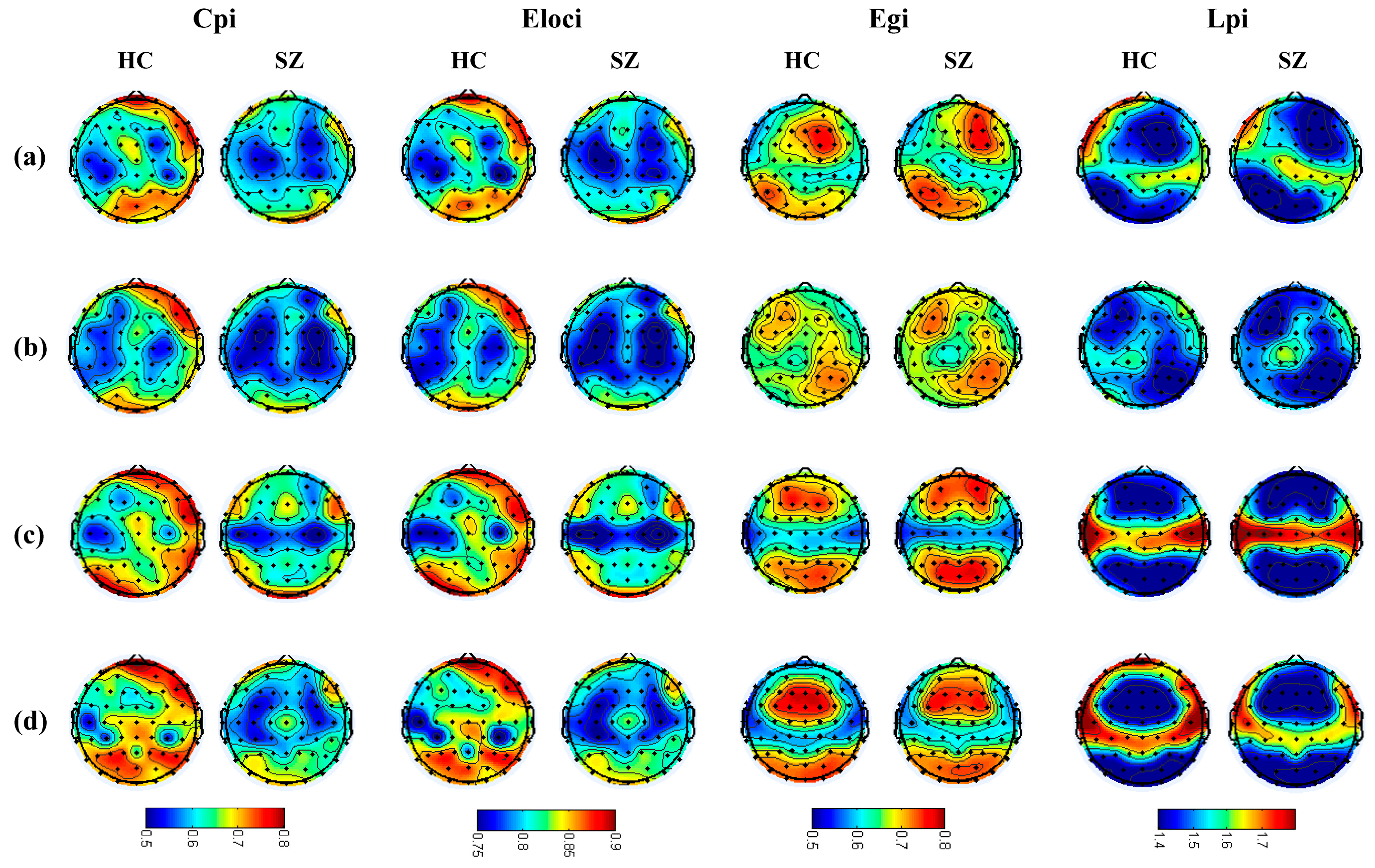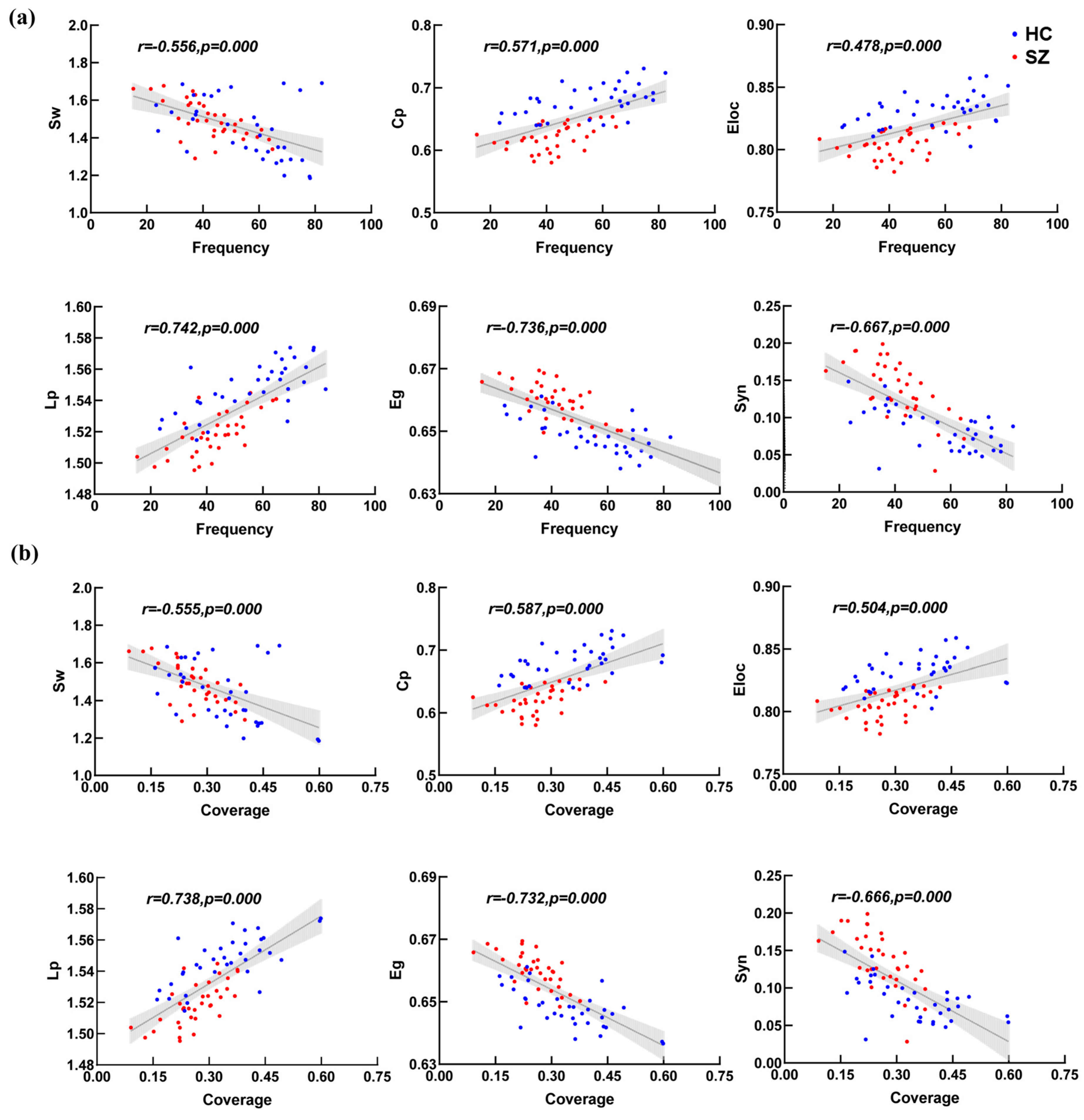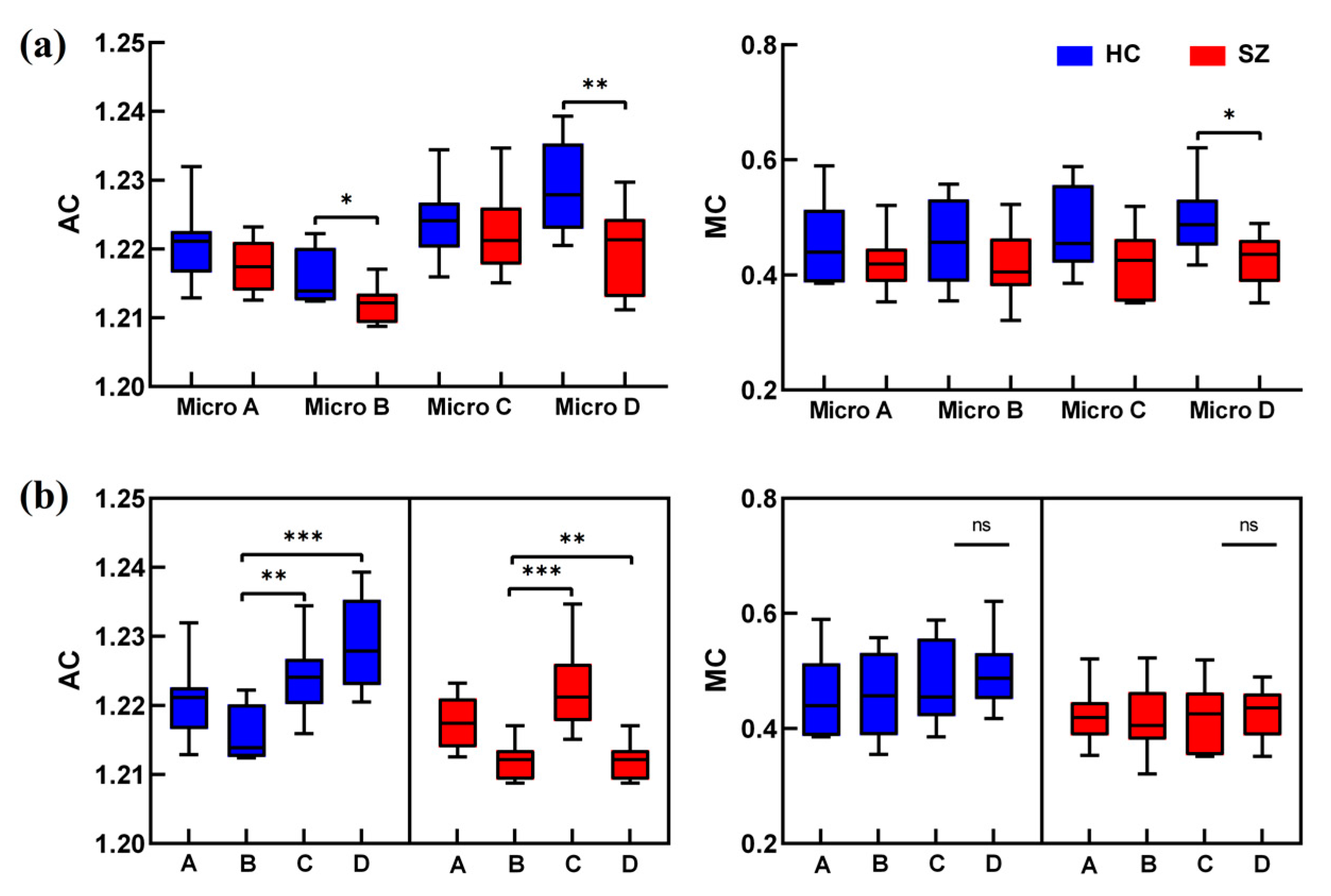Microstate D as a Biomarker in Schizophrenia: Insights from Brain State Transitions
Abstract
:1. Introduction
2. Materials and Methods
2.1. Overview
| Algorithm 1 Microstate Network Model |
| Step 1: According to the microstate template, the microstates A, B, C, and D time series are extracted for each participant. Step 2: The and channels’ signals are transformed by the Hilbert transformation: |
| Step 3: The phase of the and channels’ signals are calculated from the original signals () and transformed into conjugate signals (): |
| Step 4: According to the phases of the two signals, the average phase difference between the and signals is |
| where is the phase difference between x and y channels at time t, and represents the length of the time series, . |
2.2. Participants and Processing
2.3. Microstate Topographic Maps
2.4. Microstate Network Model
2.5. Network Local Controllability
2.6. Network Synchronization
2.7. Network Pinned Nodes
| Algorithm 2 Network Pinned Nodes Scheme |
| Input: microstate matrix , control strength , pinned nodes set ; |
| Step 1: Define parameters , ,, and calculate network node importance matrix , ; |
| Step 2: Using the linear matrix inequality (LMIs), calculate the optimal feedback gain matrix such that the maximum eigenvalue of the matrix achieves the minimum value: |
| where is the feedback gains of node , and > 0, , is the importance of node , and . |
| Step 3: Sort the nodes by descending order of gains from and select the top nodes with the highest gain values and add them to . |
2.8. Statistical Analyses
3. Results
3.1. Analysis of Microstate Network Topology
3.2. Analysis of Microstate Network Controllability
3.3. Analysis of Microstate Network Synchronization
3.4. Analysis of Microstate Network Pinned Nodes
4. Discussion
4.1. Abnormalities in Microstate Topology
4.2. Abnormalities in Microstate Controllability
4.3. Abnormalities in Microstate Synchronization
4.4. Abnormalities in Microstate Pinned Nodes
5. Conclusions
Supplementary Materials
Author Contributions
Funding
Institutional Review Board Statement
Informed Consent Statement
Data Availability Statement
Acknowledgments
Conflicts of Interest
References
- Wang, L.; Lin, S.; Tian, L.; Wu, H.; Jin, W.; Wang, W.; Pan, W.; Yang, C.; Ren, Y.; Ma, X.; et al. Subregional Thalamic Functional Connectivity Abnormalities and Cognitive Impairments in First-Episode Schizophrenia. Asian J. Psychiatry 2024, 96, 104042. [Google Scholar] [CrossRef]
- Marshall, M.; Lewis, S.; Lockwood, A.; Drake, R.; Jones, P.; Croudace, T. Association Between Duration of Untreated Psychosis and Outcome in Cohorts of First-Episode Patients: A Systematic Review. Arch. Gen. Psychiatry 2005, 62, 975. [Google Scholar] [CrossRef]
- Charernboon, T.; Chompookard, P. Detecting Cognitive Impairment in Patients with Schizophrenia with the Addenbrooke’s Cognitive Examination. Asian J. Psychiatry 2019, 40, 19–22. [Google Scholar] [CrossRef]
- Gomez-Pilar, J.; de Luis-García, R.; Lubeiro, A.; de la Red, H.; Poza, J.; Núñez, P.; Hornero, R.; Molina, V. Relations between Structural and EEG-Based Graph Metrics in Healthy Controls and Schizophrenia Patients. Hum. Brain Mapp. 2018, 39, 3152–3165. [Google Scholar] [CrossRef]
- Zhao, Z.; Wang, C.; Yuan, Q.; Zhao, J.; Ren, Q.; Xu, Y.; Li, J.; Yu, Y. Dynamic Changes of Brain Networks during Feedback-Related Processing of Reinforcement Learning in Schizophrenia. Brain Res. 2020, 1746, 146979. [Google Scholar] [CrossRef]
- Yang, W.; Xu, X.; Wang, C.; Cheng, Y.; Li, Y.; Xu, S.; Li, J. Alterations of Dynamic Functional Connectivity between Visual and Executive-Control Networks in Schizophrenia. Brain Imaging Behav. 2022, 16, 1294–1302. [Google Scholar] [CrossRef]
- Huo, S.; Tian, C.; Zheng, M.; Guan, S.; Zhou, C.; Liu, Z. Spatial Multi-Scaled Chimera States of Cerebral Cortex Network and Its Inherent Structure-Dynamics Relationship in Human Brain. Natl. Sci. Rev. 2021, 8, nwaa125. [Google Scholar] [CrossRef]
- Baradits, M.; Bitter, I.; Czobor, P. Multivariate Patterns of EEG Microstate Parameters and Their Role in the Discrimination of Patients with Schizophrenia from Healthy Controls. Psychiatry Res. 2020, 288, 112938. [Google Scholar] [CrossRef]
- Michel, C.M.; Koenig, T. EEG Microstates as a Tool for Studying the Temporal Dynamics of Whole-Brain Neuronal Networks: A Review. NeuroImage 2018, 180, 577–593. [Google Scholar] [CrossRef]
- Kleinert, T.; Koenig, T.; Nash, K.; Wascher, E. On the Reliability of the EEG Microstate Approach. Brain Topogr. 2024, 37, 271–286. [Google Scholar] [CrossRef]
- Da Cruz, J.R.; Favrod, O.; Roinishvili, M.; Chkonia, E.; Brand, A.; Mohr, C.; Figueiredo, P.; Herzog, M.H. EEG Microstates Are a Candidate Endophenotype for Schizophrenia. Nat. Commun. 2020, 11, 3089. [Google Scholar] [CrossRef]
- Seitzman, B.A.; Abell, M.; Bartley, S.C.; Erickson, M.A.; Bolbecker, A.R.; Hetrick, W.P. Cognitive Manipulation of Brain Electric Microstates. NeuroImage 2017, 146, 533–543. [Google Scholar] [CrossRef]
- Sun, Q.; Zhao, L.; Tan, L. Abnormalities of Electroencephalography Microstates in Drug-Naïve, First-Episode Schizophrenia. Front. Psychiatry 2022, 13, 853602. [Google Scholar] [CrossRef]
- Manoach, D.S.; Press, D.Z.; Thangaraj, V.; Searl, M.M.; Goff, D.C.; Halpern, E.; Saper, C.B.; Warach, S. Schizophrenic Subjects Activate Dorsolateral Prefrontal Cortex during a Working Memory Task, as Measured by fMRI. Biol. Psychiatry 1999, 45, 1128–1137. [Google Scholar] [CrossRef]
- Yao, R.; Xue, J.; Li, H.; Wang, Q.; Deng, H.; Tan, S. Dynamics and Synchronization Control in Schizophrenia for EEG Signals. Biomed. Signal Process. Control 2022, 71, 103118. [Google Scholar] [CrossRef]
- Kayser, J.; Tenke, C.E. Principal Components Analysis of Laplacian Waveforms as a Generic Method for Identifying ERP Generator Patterns: II. Adequacy of Low-Density Estimates. Clin. Neurophysiol. 2006, 117, 369–380. [Google Scholar] [CrossRef]
- De Pieri, M.; Rochas, V.; Sabe, M.; Michel, C.; Kaiser, S. Pharmaco-EEG of Antipsychotic Treatment Response: A Systematic Review. Schizophrenia 2023, 9, 85. [Google Scholar] [CrossRef]
- Rürup, L.; Mathes, B.; Schmiedt-Fehr, C.; Wienke, A.S.; Özerdem, A.; Brand, A.; Basar-Eroglu, C. Altered Gamma and Theta Oscillations during Multistable Perception in Schizophrenia. Int. J. Psychophysiol. 2020, 155, 127–139. [Google Scholar] [CrossRef]
- Gordillo, D.; da Cruz, J.R.; Chkonia, E.; Lin, W.-H.; Favrod, O.; Brand, A.; Figueiredo, P.; Roinishvili, M.; Herzog, M.H. The EEG Multiverse of Schizophrenia. Cereb. Cortex 2023, 33, 3816–3826. [Google Scholar] [CrossRef]
- Koshiyama, D.; Miyakoshi, M.; Tanaka-Koshiyama, K.; Joshi, Y.B.; Sprock, J.; Braff, D.L.; Light, G.A. Abnormal Phase Discontinuity of Alpha- and Theta-Frequency Oscillations in Schizophrenia. Schizophr. Res. 2021, 231, 73–81. [Google Scholar] [CrossRef]
- Yao, R.; Xue, J.; Yang, P.; Wang, Q.; Gao, P.; Yang, X.; Deng, H.; Tan, S.; Li, H. Dynamic Changes of Brain Networks during Working Memory Tasks in Schizophrenia. Neuroscience 2021, 453, 187–205. [Google Scholar] [CrossRef]
- Britz, J.; Díaz Hernàndez, L.; Ro, T.; Michel, C.M. EEG-Microstate Dependent Emergence of Perceptual Awareness. Front. Behav. Neurosci. 2014, 8, 163. [Google Scholar] [CrossRef]
- Antonova, I.; Bänninger, A.; Dierks, T.; Griskova-Bulanova, I.; Koenig, T.; Kohler, A. Differential Recruitment of Brain Networks during Visuospatial and Color Processing: Evidence from ERP Microstates. Neuroscience 2015, 305, 128–138. [Google Scholar] [CrossRef]
- Fu, Y.; Chen, J.; Xiong, X. Calculation and Analysis of Microstate Related to Variation in Executed and Imagined Movement of Force of Hand Clenching. Comput. Intell. Neurosci. 2018, 2018, 9270685. [Google Scholar] [CrossRef]
- Khanna, A.; Pascual-Leone, A.; Farzan, F. Reliability of Resting-State Microstate Features in Electroencephalography. PLoS ONE 2014, 9, e114163. [Google Scholar] [CrossRef]
- Stefan, S.; Schorr, B.; Lopez-Rolon, A.; Kolassa, I.-T.; Shock, J.P.; Rosenfelder, M.; Heck, S.; Bender, A. Consciousness Indexing and Outcome Prediction with Resting-State EEG in Severe Disorders of Consciousness. Brain Topogr. 2018, 31, 848–862. [Google Scholar] [CrossRef]
- Wang, Z.-M.; Zhou, R.; He, Y.; Guo, X.-M. Functional Integration and Separation of Brain Network Based on Phase Locking Value During Emotion Processing. IEEE Trans. Cogn. Dev. Syst. 2023, 15, 444–453. [Google Scholar] [CrossRef]
- Gu, S.; Pasqualetti, F.; Cieslak, M.; Telesford, Q.K.; Yu, A.B.; Kahn, A.E.; Medaglia, J.D.; Vettel, J.M.; Miller, M.B.; Grafton, S.T.; et al. Controllability of Structural Brain Networks. Nat. Commun. 2015, 6, 8414. [Google Scholar] [CrossRef]
- Fan, M.; Chou, C.-A. Detecting Abnormal Pattern of Epileptic Seizures via Temporal Synchronization of EEG Signals. IEEE Trans. Biomed. Eng. 2019, 66, 601–608. [Google Scholar] [CrossRef]
- Schöll, E. Partial Synchronization Patterns in Brain Networks. EPL 2022, 136, 18001. [Google Scholar] [CrossRef]
- Yordanova, J.; Falkenstein, M.; Kolev, V. Motor Oscillations Reveal New Correlates of Error Processing in the Human Brain. Sci. Rep. 2024, 14, 5624. [Google Scholar] [CrossRef]
- Bomela, W.; Sebek, M.; Nagao, R.; Singhal, B.; Kiss, I.Z.; Li, J.-S. Finding Influential Nodes in Networks Using Pinning Control: Centrality Measures Confirmed with Electrochemical Oscillators. Chaos Interdiscip. J. Nonlinear Sci. 2023, 33, 093128. [Google Scholar] [CrossRef]
- Keihani, A.; Sajadi, S.S.; Hasani, M.; Ferrarelli, F. Bayesian Optimization of Machine Learning Classification of Resting-State EEG Microstates in Schizophrenia: A Proof-of-Concept Preliminary Study Based on Secondary Analysis. Brain Sci. 2022, 12, 1497. [Google Scholar] [CrossRef]
- Cui, Z.; Stiso, J.; Baum, G.L.; Kim, J.Z.; Roalf, D.R.; Betzel, R.F.; Gu, S.; Lu, Z.; Xia, C.H.; He, X.; et al. Optimization of Energy State Transition Trajectory Supports the Development of Executive Function during Youth. eLife 2020, 9, e53060. [Google Scholar] [CrossRef]
- Gomez-Pilar, J.; Poza, J.; Bachiller, A.; Gómez, C.; Núñez, P.; Lubeiro, A.; Molina, V.; Hornero, R. Quantification of Graph Complexity Based on the Edge Weight Distribution Balance: Application to Brain Networks. Int. J. Neural Syst. 2018, 28, 1750032. [Google Scholar] [CrossRef]
- Gomez-Pilar, J.; Poza, J.; Gómez, C.; Northoff, G.; Lubeiro, A.; Cea-Cañas, B.B.; Molina, V.; Hornero, R. Altered Predictive Capability of the Brain Network EEG Model in Schizophrenia during Cognition. Schizophr. Res. 2018, 201, 120–129. [Google Scholar] [CrossRef]
- Ramirez-Mahaluf, J.P.; Tepper, Á.; Alliende, L.M.; Mena, C.; Castañeda, C.P.; Iruretagoyena, B.; Nachar, R.; Reyes-Madrigal, F.; León-Ortiz, P.; Mora-Durán, R.; et al. Dysconnectivity in Schizophrenia Revisited: Abnormal Temporal Organization of Dynamic Functional Connectivity in Patients With a First Episode of Psychosis. Schizophr. Bull. 2023, 49, 706–716. [Google Scholar] [CrossRef]
- Wang, C.; Wang, C.; Ren, Y.; Zhang, R.; Ai, L.; Wu, Y.; Ran, X.; Wang, M.; Hu, H.; Shen, J.; et al. Multi Feature Fusion Network for Schizophrenia Classification and Abnormal Brain Network Recognition. Brain Res. Bull. 2024, 206, 110848. [Google Scholar] [CrossRef]
- Zhang, Y.; Peng, Y.; Song, Y.; Zhou, Y.; Zhang, S.; Yang, G.; Yang, Y.; Li, W.; Yue, W.; Lv, L.; et al. Abnormal Functional Connectivity of the Striatum in First-Episode Drug-Naive Early-Onset Schizophrenia. Brain Behav. 2022, 12, e2535. [Google Scholar] [CrossRef]
- Iglesias-Parro, S.; Ruiz de Miras, J.; Soriano, M.F.; Ibáñez-Molina, A.J. Integration–Segregation Dynamics in Functional Networks of Individuals Diagnosed with Schizophrenia. Eur. J. Neurosci. 2023, 57, 1748–1762. [Google Scholar] [CrossRef]
- Wang, Y.; Hu, X.; Li, Y. Investigating Cognitive Flexibility Deficit in Schizophrenia Using Task-Based Whole-Brain Functional Connectivity. Front. Psychiatry 2022, 13, 1069036. [Google Scholar] [CrossRef]
- Gudi-Mindermann, H.; Rimmele, J.M.; Bruns, P.; Kloosterman, N.A.; Donner, T.H.; Engel, A.K.; Röder, B. Post-Training Load-Related Changes of Auditory Working Memory—An EEG Study. Front. Hum. Neurosci. 2020, 14, 72. [Google Scholar] [CrossRef]
- Wang, J.; Zuo, X.; He, Y. Graph-Based Network Analysis of Resting-State Functional MRI. Front. Syst. Neurosci. 2010, 4, 16. [Google Scholar] [CrossRef]
- Li, Q.; Yao, L.; You, W.; Liu, J.; Deng, S.; Li, B.; Luo, L.; Zhao, Y.; Wang, Y.; Wang, Y.; et al. Controllability of Functional Brain Networks and Its Clinical Significance in First-Episode Schizophrenia. Schizophr. Bull. 2023, 49, 659–668. [Google Scholar] [CrossRef]
- Chen, G.; Ding, W.; Zhang, L.; Cui, H.; Jiang, Z.; Li, Y. Neurophysiological Evidence of Compensatory Brain Mechanisms Underlying Attentional-Related Processes in Symptomatically Remitted Patients with Schizophrenia. Front. Psychol. 2017, 8, 550. [Google Scholar] [CrossRef]
- Wang, B.; Zhang, S.; Yu, X.; Niu, Y.; Niu, J.; Li, D.; Zhang, S.; Xiang, J.; Yan, T.; Yang, J.; et al. Alterations in White Matter Network Dynamics in Patients with Schizophrenia and Bipolar Disorder. Hum. Brain Mapp. 2022, 43, 3909–3922. [Google Scholar] [CrossRef]
- Mukherjee, P.; Sabharwal, A.; Kotov, R.; Szekely, A.; Parsey, R.; Barch, D.M.; Mohanty, A. Disconnection Between Amygdala and Medial Prefrontal Cortex in Psychotic Disorders. Schizophr. Bull. 2016, 42, 1056–1067. [Google Scholar] [CrossRef]
- Poppe, A.B.; Barch, D.M.; Carter, C.S.; Gold, J.M.; Ragland, J.D.; Silverstein, S.M.; MacDonald, A.W., III. Reduced Frontoparietal Activity in Schizophrenia Is Linked to a Specific Deficit in Goal Maintenance: A Multisite Functional Imaging Study. Schizophr. Bull. 2016, 42, 1149–1157. [Google Scholar] [CrossRef]
- Koshiyama, D.; Miyakoshi, M.; Joshi, Y.B.; Molina, J.L.; Tanaka-Koshiyama, K.; Sprock, J.; Braff, D.L.; Swerdlow, N.R.; Light, G.A. A Distributed Frontotemporal Network Underlies Gamma-Band Synchronization Impairments in Schizophrenia Patients. Neuropsychopharmacology 2020, 45, 2198–2206. [Google Scholar] [CrossRef]
- Pan, Z.; Xiong, D.; Xiao, H.; Li, J.; Huang, Y.; Zhou, J.; Chen, J.; Li, X.; Ning, Y.; Wu, F.; et al. The Effects of Repetitive Transcranial Magnetic Stimulation in Patients with Chronic Schizophrenia: Insights from EEG Microstates. Psychiatry Res. 2021, 299, 113866. [Google Scholar] [CrossRef]
- Tamano, R.; Ogawa, T.; Katagiri, A.; Cai, C.; Asai, T.; Kawanabe, M. Event-Related Microstate Dynamics Represents Working Memory Performance. NeuroImage 2022, 263, 119669. [Google Scholar] [CrossRef] [PubMed]
- Costanzo, E.Y.; Villarreal, M.; Drucaroff, L.J.; Ortiz-Villafañe, M.; Castro, M.N.; Goldschmidt, M.; Wainsztein, A.E.; Ladrón-de-Guevara, M.S.; Romero, C.; Brusco, L.I.; et al. Hemispheric Specialization in Affective Responses, Cerebral Dominance for Language, and Handedness: Lateralization of Emotion, Language, and Dexterity. Behav. Brain Res. 2015, 288, 11–19. [Google Scholar] [CrossRef] [PubMed]
- Ocklenburg, S.; Gunturkun, O. Hemispheric Asymmetries: The Comparative View. Front. Psychol. 2012, 3, 5. [Google Scholar] [CrossRef] [PubMed]
- Zhao, Y.; Li, Y.; Du, J.; Fang, C.; Li, W.; Lv, M.; Wu, Y.; Wang, K.; Wu, T.; Tian, Y.; et al. Modulation of Hemispheric Asymmetry in Executive Control of Attention in Schizophrenia with Atypical Antipsychotic Treatment: Potential Benefits of Olanzapine. Schizophr. Res. Cogn. 2024, 36, 100306. [Google Scholar] [CrossRef] [PubMed]
- Biel, A.L.; Sterner, E.; Röll, L.; Sauseng, P. Modulating verbal working memory with fronto-parietal transcranial electric stimulation at theta frequency: Does it work? Eur. J. Neurosci. 2022, 55, 405–425. [Google Scholar] [CrossRef] [PubMed]
- Jun, S.; Joo, Y.; Sim, Y.; Pyo, C.; Ham, K. Fronto-parietal single-trial brain connectivity benefits successful memory recognition. Transl. Neurosci. 2022, 13, 506–513. [Google Scholar] [CrossRef]
- Gogtay, N.; Giedd, J.N.; Lusk, L.; Hayashi, K.M.; Greenstein, D.; Vaituzis, A.C.; Nugent, T.F.; Herman, D.H.; Clasen, L.S.; Toga, A.W.; et al. Dynamic mapping of human cortical development during childhood through early adulthood. Proc. Natl. Acad. Sci. USA 2004, 101, 8174–8179. [Google Scholar] [CrossRef]
- Coffman, B.A.; Murphy, T.K.; Haas, G.; Olson, C.; Cho, R.; Ghuman, A.S.; Salisbury, D.F. Lateralized evoked responses in parietal cortex demonstrate visual short-term memory deficits in first-episode schizophrenia. J. Psychiatr. Res. 2020, 130, 292–299. [Google Scholar] [CrossRef]
- Tranfa, M.; Iasevoli, F.; Cocozza, S.; Ciccarelli, M.; Barone, A.; Brunetti, A.; de Bartolomeis, A.; Pontillo, G. Neural substrates of verbal memory impairment in schizophrenia: A multimodal connectomics study. Hum. Brain Mapp. 2023, 44, 2829–2840. [Google Scholar] [CrossRef]
- Kim, K.; Duc, N.T.; Choi, M.; Lee, B. EEG microstate features for schizophrenia classification. PLoS ONE 2021, 16, e0251842. [Google Scholar] [CrossRef]
- Lehmann, D.; Faber, P.L.; Galderisi, S.; Herrmann, W.M.; Kinoshita, T.; Koukkou, M.; Mucci, A.; Pascual-Marqui, R.D.; Saito, N.; Wackermann, J.; et al. EEG microstate duration and syntax in acute, medication-naïve, first-episode schizophrenia: A multi-center study. Psychiatry Res. Neuroimaging 2005, 138, 141–156. [Google Scholar] [CrossRef] [PubMed]









Disclaimer/Publisher’s Note: The statements, opinions and data contained in all publications are solely those of the individual author(s) and contributor(s) and not of MDPI and/or the editor(s). MDPI and/or the editor(s) disclaim responsibility for any injury to people or property resulting from any ideas, methods, instructions or products referred to in the content. |
© 2024 by the authors. Licensee MDPI, Basel, Switzerland. This article is an open access article distributed under the terms and conditions of the Creative Commons Attribution (CC BY) license (https://creativecommons.org/licenses/by/4.0/).
Share and Cite
Yao, R.; Song, M.; Shi, L.; Pei, Y.; Li, H.; Tan, S.; Wang, B. Microstate D as a Biomarker in Schizophrenia: Insights from Brain State Transitions. Brain Sci. 2024, 14, 985. https://doi.org/10.3390/brainsci14100985
Yao R, Song M, Shi L, Pei Y, Li H, Tan S, Wang B. Microstate D as a Biomarker in Schizophrenia: Insights from Brain State Transitions. Brain Sciences. 2024; 14(10):985. https://doi.org/10.3390/brainsci14100985
Chicago/Turabian StyleYao, Rong, Meirong Song, Langhua Shi, Yan Pei, Haifang Li, Shuping Tan, and Bin Wang. 2024. "Microstate D as a Biomarker in Schizophrenia: Insights from Brain State Transitions" Brain Sciences 14, no. 10: 985. https://doi.org/10.3390/brainsci14100985





